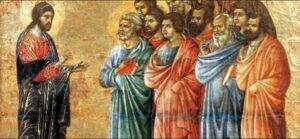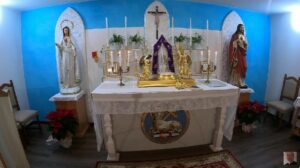
Then Jesus said, Neither will I condemn you. Go your way, and from now on sin no more.
ORARI S.MESSA DI OGGI SABATO 26 MARZ0 2022, ORE 8.00 – Sabbato infra Hebdomadam III in Quadragesima ~ III. classis
S.MESSA ONLINE DI DON ENRICO RONCAGLIA, su youtube channel:
https://www.youtube.com/channel/UCYYDj4O4e11cE7XNtngkoJA
e qui:
LITURGIA IN LATINO\ENGLISH:
https://divinumofficium.com/cgi-bin/missa/missa.pl
COMMUNIO PREGHIERE\PRAYERS:
https://www.proselitismodellascienza.it/2021/10/25/communio-e-comunione-spirituale/
EVANGELIUM E OMELIA\HOMILY:
Evangelium
Ioann 8:1-11
In illo témpore: Perréxit Iesus in montem Olivéti: et dilúculo íterum venit in templum, et omnis pópulus venit ad eum, et sedens docébat eos. Addúcunt autem scribæ et pharisǽi mulíerem in adultério deprehénsam: et statuérunt eam in médio, et dixérunt ei: Magister, hæc mulier modo deprehénsa est in adultério. In lege autem Moyses mandávit nobis huiúsmodi lapidáre. Tu ergo quid dicis? Hoc autem dicébant tentántes eum, ut possent accusáre eum. Iesus autem inclínans se deórsum, dígito scribébat in terra. Cum ergo perseverárent interrogántes eum, eréxit se, et dixit eis: Qui sine peccáto est vestrum, primus in illam lápidem mittat. Et íterum se inclínans, scribébat in terra. Audiéntes autem unus post unum exíbant, incipiéntes a senióribus: et remánsit solus Iesus, et múlier in médio stans. Erigens autem se Iesus, dixit ei: Múlier, ubi sunt, qui te accusábant? nemo te condemnávit? Quæ dixit: Nemo, Dómine. Dixit autem Iesus: Nec ego te condemnábo: Vade, et iam ámplius noli peccáre.
Gospel
John 8:1-11
At that time, Jesus went to the Mount of Olives. And at daybreak He came again into the temple, and all the people came to Him; and sitting down He began to teach them. Now the Scribes and Pharisees brought a woman caught in adultery, and setting her in the midst, said to Him, Master, this woman has just now been caught in adultery. And in the Law Moses commanded us to stone such persons. What, therefore, do You say? Now they were saying this to test Him, in order that they might be able to accuse Him. But Jesus, stooping down, began to write with His finger on the ground. But when they continued asking Him, He raised Himself and said to them, Let him who is without sin among you be the first to cast a stone at her. And again stooping down, He began to write on the ground. But hearing this, they went away, one by one, beginning with the eldest. And Jesus remained alone, with the woman standing in the midst. And Jesus, raising Himself, said to her, Woman, where are they? Has no one condemned you? She said, No one, Lord. Then Jesus said, Neither will I condemn you. Go your way, and from now on sin no more.
.
DALL’OMELIA DI (FROM THE HOMILY BY) DON ENRICO RONCAGLIA – ORARI S.MESSA DI OGGI SABATO 26 MARZ0 2022, ORE 8.00

DALL’OMELIA DI DON ENRICO RONCAGLIA (*)
Dan 9:15-17, 19-30, 33-62
In quei giorni dimorava in Babilonia un uomo chiamato Ioachim. Egli aveva sposato una donna chiamata Susanna, figlia di Elcia, bellissima e timorata di Dio, avendo i suoi genitori, che erano giusti, educata la figliuola secondo la legge di Mosè.
Joann 8:1-11
Allora, Gesù, alzatosi, le disse: « Dove sono, o donna, quelli che ti accusavano? Nessuno ti ha condannata?». Ed ella: «Nessuno, Signore». E Gesù le disse: «Nemmeno io ti condannerò: va’ e d’ora in poi non peccare più».
I due brani si assomigliano. La figura di Susanna rappresenta l’innocente condannato a morte (prefigurazione del Messia), da parte dei giudici anziani, per l’accusa di adulterio. Ma il Signore suscita un ragazzo, il profeta Daniele, per salvarla.
Nel Vangelo, invece, la donna (che rappresenta noi) e’ realmente colpevole di adulterio. Ma nessuno la condanna (chi e’ senza peccato scagli la prima pietra).
Gesu’ la salva (e’ Lui il Salvatore!) e la assolve esortandola a non peccare piu’.
Sia lodato Gesu’ Cristo! Sempre sia lodato!.
__________________
(*) Questo commento e’ scritto in tempo reale durante l’omelia. Mi scuso per l’eventuale misinterpretazione delle parole di Don Enrico.
FROM THE HOMILY BY DON ENRICO RONCAGLIA (**)
Dan 9: 15-17, 19-30, 33-62 In those days a man named Ioachim was living in Babylon. He had married a woman named Susanna, daughter of Elcia, beautiful and God-fearing, having her parents, who were righteous, educated her daughter according to the law of Moses.
Joann 8: 1-11 Then Jesus stood up and said to her: «O woman, where are those who accused you? Has no one condemned you? ». And she: «Nobody, Lord». And Jesus said to her: “Not even I will condemn you: go and from now on do not sin anymore”.
The two episodes are similar. The figure of Susanna represents the innocent sentenced to death (prefiguration of the Messiah), by the senior judges, for the accusation of adultery.
But the Lord raises up a boy, the prophet Daniel (to save her).
In the Gospel, however, the woman (who represents us) is truly guilty of adultery. But no one condemns it (which is without sin, cast the first stone).
Jesus saves (He is our Savior!) and absolves her by exhorting her not to sin anymore.
Praised be Jesus Christ. Always be praised!
__________________
(*) This comment is written in real time during the homily. I apologize for any misinterpretation of Don Enrico’s words.Edit

